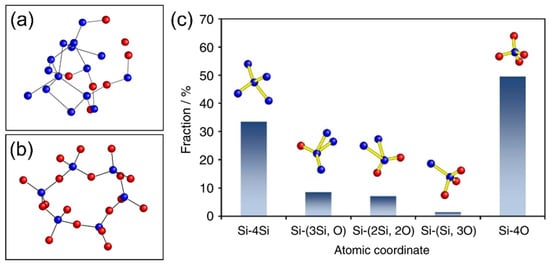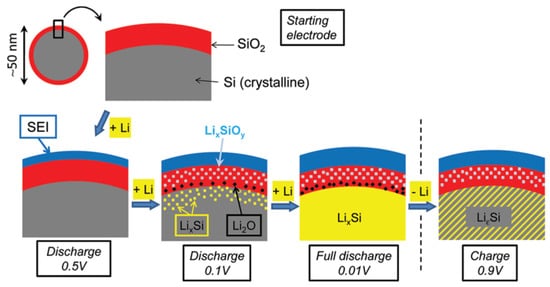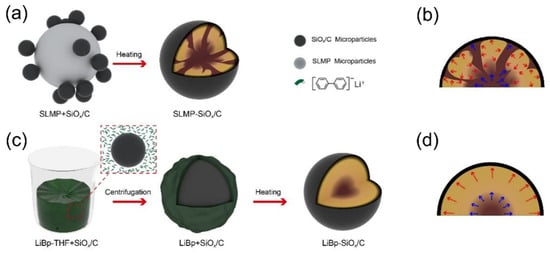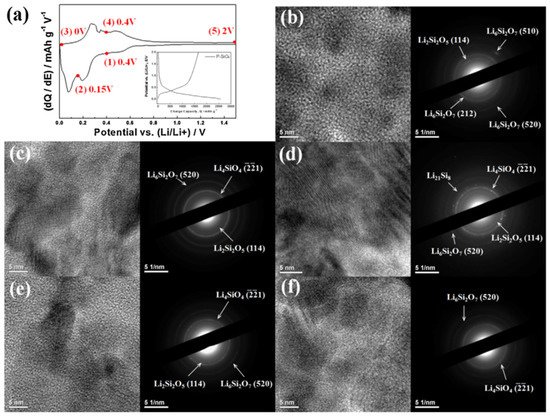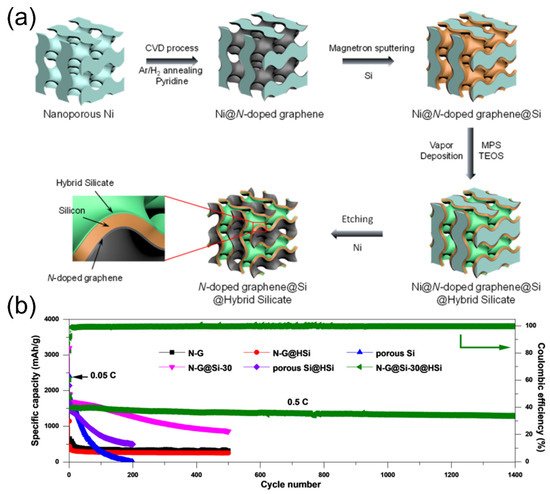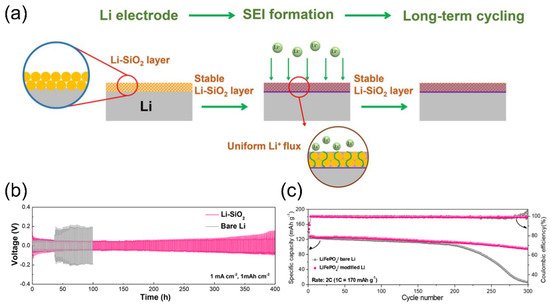The success of lithium silicates in SiO/SiO
X-based anodes has prompted researchers to investigate their use in high-capacity silicon and lithium metal anode systems. Both anodes have unsettled problems, such as dramatic volume change, unstable interfacial reactions, and poor cycle performance [
45,
46,
47,
48,
49]. In a typical SiO anode, the lithium silicates formed in situ after the initial lithiation act as a rigid framework to accommodate the swelled Li
xSi alloy, and the lithium silicates in the structure can provide good ionic channels at the same time [
11].
Figure 7 displays the common positional design of lithium silicates in SiO/SiO
x, nano-Si, and lithium metal anode materials. Both SiO and nano-Si are in powder form, but only SiO possesses a structure with dispersed lithium silicates. On the other hand, lithium silicates are usually applied as a coating layer in nano-Si and metallic lithium anodes. Methods of applying lithium silicates in anode structures have been extensively developed. Below, we give some examples of how to employ lithium silicates in order to stabilize the electrochemical reactions of silicon and lithium metal anode materials, thereby prolonging their cycle life.
4.1. Lithium Silicates in Silicon Anodes
Cao et al. analyzed the composition of SEI formed on the native oxide-covered silicon anodes by employing in situ synchrotron X-ray reflectivity, linear sweep voltammetry, and ex situ XPS [
16]. The inorganic SEI comprised two well-defined structures, which can be divided into a bottom SEI layer (adjacent to the electrode) and a top SEI layer (adjacent to the organic SEI layer from electrolyte decomposition), as shown in
Figure 8. At open circuit voltage (OCV), the silicon surface is terminated by the pristine native silica (
Figure 8A). While lithiation begins and the anode voltage drops to 0.8 V vs. Li/Li
+, the organic SEI starts to form on the silicon anode, and native silica remains unchanged (
Figure 8B). At 0.7 V, the lithiation of the native oxide layer initiates and transforms into lithium silicates (Li
xSiO
y) [
16,
50,
51] and lithium silicide alloys (Li
xSi) as the bottom SEI layer (
Figure 8C). This finding is also in consistent with another report, which concluded that the lithiation voltage of SiO
2 is higher than that of Si [
14]. Between 0.6 V and 0.3 V, the top SEI, consisting of LiF and other products, is formed in between the organic SEI and bottom SEI, and lithiation of the bottom SEI continues (
Figure 8D). At 0.2 V, the last step of SEI formation, Li
2O is formed in the bottom SEI layer, which is thicker than the top SEI (
Figure 8E). The authors concluded that a smooth Li
xSiO
y layer as the bottom SEI can secure the growth of a conformal, smooth, and thin top SEI layer, and both cycle stability and rate performance can be guaranteed [
16]. It was reported that Li
4SiO
4 should be the final lithium silicate product from the lithiation of either native oxide or artificial oxide grown on an Si surface, and a small lithiation current is necessary to activate the electrochemical synthesis of lithium silicates [
23,
52].
Figure 8. (
A–
E) Schematic drawing illustrating the proposed voltage-dependent SEI growth mechanism on native oxide-terminated silicon anodes. Reproduced with permission from ref. [
16]. Copyright 2018, Elsevier.
In addition to lithium-silicate-based SEI derived from native oxide, another approach to directly deposit lithium silicates onto silicon as an artificial SEI can be implemented for superior battery anode performance. Zhu et al. synthesized a Si@Li
2SiO
3 core-shell anode by oxidizing silicon nanoparticles at 600 °C in air with a subsequent thermal prelithiation process [
53]. In comparison with the non-prelithiated Si@SiO
x anode, Si@Li
2SiO
3 showed a much better initial Coulombic efficiency of 89.1% (vs. 66.5% in Si@SiO
x and 56.8% in Si), indicating prelithiation treatment can minimize irreversible Li-ion consumption during SEI formation reactions. Cycling tests also revealed that Si@Li
2SiO
3 electrodes outperformed Si@SiO
x and Si not only in specific capacity but also in cycling stability. The Li
2SiO
3 shell did slightly contribute to a charge/discharge capacity of 105.3/125.3 mA h g
−1, which is consistent with the results of lithium activity discussed in the previous section [
29]. The authors also demonstrated that the electron and Li-ion diffusion pathways of the Li
2SiO
3 layer on the Si surface are better than those of the SiO
x layer by comparing their reaction resistances, leading to an outstanding rate capability [
53].
Huang et al. utilized nanoporous nickel as the substrate to be coated with N-doped graphene (via CVD process), silicon (via magnetron sputtering), and hybrid silicate (via vapor deposition) to build a sandwiched N-doped graphene@Si@hybrid silicate (N-G@Si@HSi) nanoarchitecture [
54].
Figure 9a shows the step-by-step details of the fabrication process of the bicontinuous porous material. A hybrid silicate was derived from the reactions of 3-mercaptopropyl trimethoxysilane (MPS), tetraethyl orthosilicate (TEOS) precursors, and H
2O vapors after a mild heating process. After the last nickel etching step, the free-standing film was used as the anode. The N-G@Si-30@HSi (Si-30: 59 nm silicon deposition thickness) exhibited extremely stable cycle performance among the other anode deigns in
Figure 9b. In the ingenious sandwiched anode design, the N-doped graphene serves as a flexible and conductive support, and the porous silicon nanolayer can avoid severe volume expansion and pulverization [
6,
55,
56,
57,
58,
59,
60,
61]. The amorphous external coating of hybrid lithium silicates plays an important role to significantly enhance the robustness and integrity of the structure and to facilitate the formation of stable SEI films [
54].
Figure 9. (
a) Schematic drawing illustrating the fabrication process of the nanoporous N-G@Si@HSi anode. (
b) Cycling performance of the N-G, N-G@HSi, porous Si, N-G@Si-30, porous Si@HSi, and N-G@Si-30@HSi electrodes at 0.05 C for the initial three cycles and at 0.5 C for the extended cycles. Reproduced with permission from ref. [
54]. Copyright 2020, ACS Publications.
4.2. Lithium Silicates in Lithium Metal Anodes
A Li
4SiO
4 passivation layer can be formed on lithium metal anodes by in situ reactions between lithium foil and the a-SiO
2 thin film derived from electron cyclotron resonance (ECR)−chemical vapor deposition (CVD) [
62].
Figure 10 exhibits the hierarchical structure of the composite lithium metal anode, which varies with a-SiO
2 deposition time, which is proportional to the thickness of the passivation layer. Without any interfacial protection, a rough surface was clearly found in the pristine lithium anode after lithiation (bottom left in
Figure 10), and severe voltage polarization worsened with increasing cycle numbers due to significant degradation of the ether-based electrolyte [
63]. While a-SiO
2 was deposited onto the lithium metal, a thin lithium silicide and lithiated silicon oxide bilayer was simultaneously generated by the immediate reactions with lithium. With a longer deposition time, pure a-SiO
2 started to exist on top of the bilayer, and the thickness of a-SiO
2 grew with the process time. After lithiation, the a-SiO
2 top layer was converted into Li
4SiO
4, leading to a dendrite-free surface (SL-3 sample shown in the bottom of
Figure 10), showing a flat plating/stripping voltage plateau with a minimal overpotential of 21.7 mV during repeated cycling, which represents excellent interfacial stability [
62,
64]. When the a-SiO
2 layer became too thick, not only ionically conductive Li
4SiO
4 but also relatively insulating SiO was formed in the artificial top-layer structure, resulting in a higher overpotential due to the thicker protective layer’s longer Li-ion migration distance and poorer diffusivity due to a higher SiO/Li
4SiO
4 area ratio [
62]. A few cracks were found in the lithium metal anode samples, particularly with a thicker a-SiO
2 protective layer, due to the heavy electrical stress induced by high electrical resistance, thereby leading to high interfacial resistance [
62,
65]. As a result, owing to higher Li-ion conductivity and Young’s modulus (141.1 GPa) of Li
4SiO
4 than those of a-SiO
2, a carefully designed Li
4SiO
4 artificial layer can serve as an excellent protective interface to stabilize the electrochemical reactions of lithium metal anodes [
62].
Figure 10. Schematic drawing illustrating the silicon oxide-based passivation layer deposited on the surface of lithium metal anode by the ECR-CVD method. Reproduced with permission from ref. [
62]. Copyright 2018, ACS Publications.
A similar approach was developed by applying a-SiO
2 nanoparticles top of a lithium metal anode [
66]. Silica spherical powders (200–300 nm in diameter) were sprayed onto a fresh lithium foil, followed by rolling-pressing to improve adherence. A compact and conformal SiO
2 layer with a thickness of 3.6 μm then functioned as the artificial interfacial layer to stabilize the lithium-plating and stripping behaviors in lithium metal batteries (
Figure 11a). The porous SiO
2 layer transformed into Li
4SiO
4 after prelithiation, and zigzagged channels that can facilitate Li-ion transfer were formed between Li
4SiO
4 particles. This protective film remained integrated after extended cycles, which guarantees low polarization (
Figure 11b) and great cycle performance (
Figure 11c). Unlike previously mentioned continuous a-SiO
2 film fabricated via the ECR-CVD method [
62], a layer consisting of a-SiO
2 powder has plenty of interstices, where SEI species, such as LiF, can infiltrate during initial formation cycles [
66]. This Li
4SiO
4 hybrid structure possesses higher Young’s modulus (up to 8.81 GPa), lower Li-ion diffusion barrier, and flexibility to accommodate volume expansion [
66]. Therefore, great cyclability and rate performance originating from stable interfacial reactions and enhanced charge-transfer kinetics can be obtained.
Figure 11. (
a) Schematic drawing illustrating the fabrication of a conformal Li
4SiO
4-based hybrid layer for the dendrite-proof metallic lithium anode. (
b) Electrochemical cycling stability of bare Li and modified Li symmetric cells (1 mA cm
−2, 1 mA h cm
−2). (
c) Long-term cycling performance of Li metal full cells. Reproduced with permission from ref. [
66]. Copyright 2020, ACS Publications.
Liu et al. directly exposed a piece of lithium foil to MPS and TEOS vapors, and lithium silicates (Li
xSi
yO
z) were formed and bound with surface Li
2O and LiOH, which were naturally generated on the lithium metal before vapor deposition [
67]. It was reported that when the hydroxyl group on lithium reacts with TEOS, the protective film formed in situ possesses a self-healing feature that can dynamically repair the corroded metallic lithium anode, which, remarkably, improves its reversibility [
68]. Since MPS and TEOS are both organosilicon compounds, methoxysilane (–Si–OCH
3, from MPS) and ethoxysilane (–Si–OCH
2CH
3, from TEOS) can undergo hydrolysis and condensation reactions to create a hybrid organic–inorganic lithium silicate layer comprising a “soft” organic moiety (mercaptopropyl groups) and a “hard” inorganic moiety (lithium silicates) [
67]. The soft part in the artificial layer can improve flexibility and robustness, and the hard part can enhance Li-ion transport and block the growth of lithium dendrite. Both organic and inorganic structures synergistically stabilize anode reactions of lithium metal during charge and discharge, leading to great cycle life in Li–LiFePO
4 and Li–S full cells [
67]. Ju et al. adopted aluminum silicate fibers to protect lithium metal anodes, realizing dendrite-free lithium anode reactions and a fast Li-ion conducting interface [
69]. Inorganic species of lithium aluminates (Li
xAlO
y) and lithium silicates (Li
xSiO
y) were detected upon cycling, implying alternative metal silicates could also be used as precursors of artificial SEI for lithium metal anodes.
Liang et al. floated lithium metal foil on a solution of 3-glycidyloxypropyltrimethoxysilane (GPTMS) and LiOH, and Li
6Si
2O
7 particles were adaptively embedded in the Si–O–Si polymer as a protective dual-phase layer during the initial lithium-stripping/plating process [
70]. This dual-phase interface showed high elastic modulus, high mechanical rigidity, and high interface energy, which can suppress the formation of one-dimensional lithium dendrite whiskers [
71]. Moreover, the structure of the composite shielding layer can efficiently lower the Li-ion migration barrier [
72]. An Li–air battery with an adaptive polymer-inorganic hybrid structure on the lithium metal anode can perform up to 180 cycles in an air atmosphere (25 °C, 15% humidity) with a capacity limitation of 1000 mAh g
−1 under a high current density of 1000 mA g
−1 [
70]. Yu et al. employed the self-healing protective film concept by not only treating lithium metal foil in TEOS as the anode but using TEOS as an additive in the electrolyte for film-forming purposes during cycling [
68]. A thin lithium silicate layer can be formed under the reaction between TEOS and the detrimental corrosion products LiOH on the surface of lithium metal anodes in the highly corrosive environment of Li–O
2 batteries. The shielded lithium metal anode with film-forming electrolyte additive gives Li–O
2 batteries a considerable boost in cycle life (up to 144 cycles), indicating great dynamic-repair capability of the protective layer on the lithium metal anode [
68].
Lithium silicates can also be used to serve as a bridge layer between lithium metal anodes and solid-state electrolytes to lower the interfacial resistance. To achieve a low interfacial resistance with lithium metal of the garnet solid electrolyte, an amorphous Li
2SiO
3 interlayer was proposed [
73]. A liquid-phase coating process was utilized to deposit a thin lithium silicate film on the surface of garnet solid electrolytes, followed by a heat treatment, and metallic lithium was directly pressed onto the modified surface. This approach achieved stable cycling performance and a low interfacial resistance of 44 Ω cm
2, which was more than 10 times lower than that of the uncoated solid electrolyte. The authors proposed a possible reaction mechanism whereby Li
2SiO
3 decomposed into Li
21Si
5 and Li
2O after being in contact with lithium metal [
73].
To sum up, there are many approaches using lithium silicates with various Li/Si ratios to improve anode performance in Li-ion and Li metal batteries. The majority of previous research focused on the Li4SiO4 protective coating on silicon and metallic lithium anodes. With a rational design of composite anode structure, unwanted interfacial reactions can be either suppressed or eliminated, leading to better performance of long cycle life and small overpotential. The swelling issue of Si-based anodes can be addressed by utilizing SiO anodes where lithium silicates are formed in situ during cell formation or by adopting a 3D framework to accommodate lithium silicate-protected silicon. Table 1 summarizes the previous works employing lithium silicates to boost battery anode performance. The studies related to modified metallic lithium anodes utilized excess lithium in the full cell. Without detailed full-cell design parameters, their specific capacity cannot be confirmed at this point. Still, other lithium silicate phases, such as Li2Si2O5 and Li6Si2O7, have yet to be identified as a good anode-protection-layer material, like Li4SiO4 and Li2SiO3. As a result, additional in-depth research is required before a sound judgment can be reached.
Table 1. Electrochemical performance of anode materials protected by lithium silicates.
